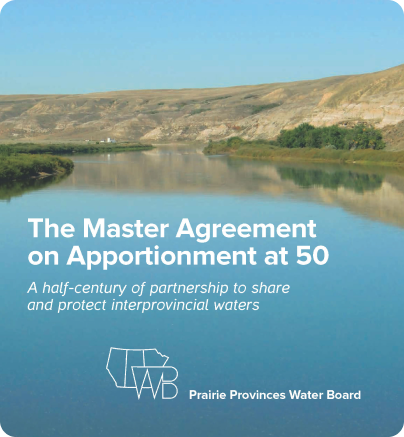1969 Master Agreement on Apportionment

2019 marks 50 years of collaborative water management in the Canadian Prairie region.
For a half-century, the MAA has allowed the Prairie Provinces to successfully manage the evolving needs and expectations of government, business and the public when it comes to shared waterways.
The MAA came into force in 1969, although the intergovernmental Prairie Provinces Water Board that administers the Agreement was established
two decades earlier.
Much of the MAA’s enduring success is attributable to a structure that encourages collaboration amongst governments on common goals, and respects each Province’s autonomy to independently manage water resources as established in the Natural Resources Transfer Acts of 1930.
For all the details, view our Anniversary Brochure
The 1969 MAA
In 1948, Alberta Saskatchewan, Manitoba and Canada signed the Prairie Provinces Water Board Agreement. This Agreement established a Board to recommend the best use of interprovincial waters, and to recommend allocations between provinces. After some twenty years, changes in regional water management philosophies resulted in a need to modify the role of the Board, Consequently, the four governments entered into the Master Agreement on Apportionment on October 30, 1969. This Agreement provided an apportionment formula for eastward flowing interprovincial streams, gave recognition to the problem of water quality, and reconstituted the Prairie Provinces Water Board. The Agreement continues forever unless all the Signatory Parties formally change the Agreement.
The Master Agreement on Apportionment contains an introduction and five schedules. These Schedules are:
- Master Agreement on Apportionment - The main body of the Agreement
- Schedule A - An apportionment agreement between Alberta and Saskatchewan.
- Schedule B - An apportionment agreement between Saskatchewan and Manitoba.
- Schedule C - the Prairie Provinces Water Board Agreement describing the composition, functions and duties of the Board.
- Schedule D - A listing of Orders-in-Council for allocations of interprovincial waters made before 1969.
- Schedule E - A Water Quality Agreement describing the role of the PPWB in interprovincial water quality management and establishing PPWB Water Quality Objectives for 12 interprovincial river reaches. This Schedule became part of the Master Agreement in 1992. Interprovincial Water Quality Objectives were updated in 2015 and in 2021.
The Master Agreement on Apportionment has been amended in 1984, 1992 and 1999. The three amending Agreements are:
- Amending Agreement to the Master Agreement on Apportionment and to the First Agreement (1984).
- Amending Agreement to the Master Agreement on Apportionment and to Schedule C (1992).
- Amending Agreement to the Master Agreement on Apportionment and to Schedules A, B and C thereto (1999).
Related Files
Feel free to download the complete text of the Agreement. This 2021 version includes the Bylaws, Rules and Procedures.
The MAA was signed in 1969 by Canada and the governments of Alberta, Saskatchewan, and Manitoba in recognition of the need to cooperatively share and manage interprovincial waters for the benefit of present and future generations.
